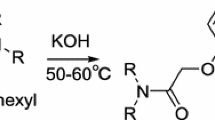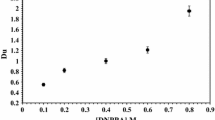Abstract
Selective separation of uranium using bis(2,4,4-trimethylpentyl)phosphinic acid in xylene and C8mimNTf2 was investigated. For ionic liquid based system, the extraction kinetics was found to be slower with the predominance of ion exchange mechanism through [UO2(NO3)·2L]+, while for xylene based system solvation mechanism. The nature of the extracted species was found to be different in both the media as observed in luminescence study. Ionic liquid based system was more radioresistant than that of molecular diluents. Na2CO3 was successfully used for stripping. The selectivity was investigated by processing simulated high level waste of pressurized heavy water reactor origin.









Similar content being viewed by others
References
Quach DL, Mincher BJ, Wai CM (2014) Supercritical fluid extraction and separation of uranium from other actinides. J Hazard Mater 274:360–366
Ansari SA, Mohapatra PK, Manchanda VK (2009) A novel malonamide grafted polystyrene-divinyl benzene resin for extraction, pre-concentration and separation of actinides. J Hazard Mater 161:1323–1329
Mahanty BN, Raut DR, Mohapatra PK, Das DK, Behere PG, Afzal Md (2014) Comparative evaluation of actinide ion uptake by polymer inclusion membranes containing TODGA as the carrier extractant. J Hazard Mater 275:146–153
Raju ChSK, Subramanian MS (2007) Sequential separation of lanthanides, thorium and uranium using novel solid phase extraction method from high acidic nuclear wastes. J Hazard Mater 145:315–322
Bhattacharyya A, Mohapatra PK, Gadly T, Raut DR, Ghosh SK, Manchanda VK (2011) Liquid–liquid extraction and flat sheet supported liquid membrane studies on Am(III) and Eu(III) separation using 2,6-bis(5,6-dipropyl-1,2,4-triazin-3-yl)pyridine as the extractant. J Hazard Mater 195:238–244
Yantasee W, Fryxell GE, Addleman RS, Wiacek RJ, Koonsiripaiboon V, Pattamakomsan K, Sukwarotwat V, Xu J, Raymond KN (2009) Selective removal of lanthanides from natural waters, acidic streams and dialysate. J Hazard Mater 168:1233–1238
Ansari SA, Pathak PN, Manchanda VK (2005) N,N,N′,N′-Tetraoctyl diglycolamide (TODGA): a promising extractant for actinide-partitioning from high-level waste (HLW). Solv Extr Ion Exch 23:463–479
Rout A, Venkatesan KA, Srinivasan TG, Rao PRV (2012) Liquid–liquid extraction of Pu(IV), U(VI) and Am(III) using malonamide in room temperature ionic liquid as diluent. J Hazard Mater 221–222:62–67
Gao S, Sun T, Chen Q, Shen X (2013) Improvement of the cloud point extraction of uranyl ions by the addition of ionic liquids. J Hazard Mater 263:562–568
Zeng X, Li J (2014) Innovative application of ionic liquid to separate Al and cathode materials from spent high-power lithium-ion batteries. J Hazard Mater 271:50–56
Zhu P, Chen Y, Wang LY, Qian GY, Zhou M, Zhou J (2012) A new technology for separation and recovery of materials from waste printed circuit boards by dissolving bromine epoxy resins using ionic liquid. J Hazard Mater 239–240:270–278
Escudero LB, Wuilloud RG, Olsina RA (2013) Sensitive determination of thallium species in drinking and natural water by ionic liquid-assisted ion-pairing liquid–liquid microextraction and inductively coupled plasma mass spectrometry. J Hazard Mater 244–245:380–386
Sun X, Ji Y, Zhang L, Chen J, Li D (2010) Separation of cobalt and nickel using inner synergistic extraction from bifunctional ionic liquid extractant (Bif-ILE). J Hazard Mater 182:447–452
Ge HL, Liu SS, Su BX, Qin LT (2014) Predicting synergistic toxicity of heavy metals and ionic liquids on photobacterium. J Hazard Mater 268:77–83
Molaakbari E, Mostafavi A, Afzali D (2011) Ionic liquid ultrasound assisted dispersive liquid–liquid microextraction method for preconcentration of trace amounts of rhodium prior to flame atomic absorption spectrometry determination. J Hazard Mater 185:647–652
Kalidhasan S, Santhana Krishna Kumar A, Rajesh V, Rajesh N (2012) An efficient ultrasound assisted approach for the impregnation of room temperature ionic liquid onto Dowex 1 × 8 resin matrix and its application toward the enhanced adsorption of chromium (VI). J Hazard Mater 213–214:249–257
Billard I, Ouadi A, Gaillard C (2011) Liquid–liquid extraction of actinides, lanthanides, and fission products by use of ionic liquids: from discovery to understanding. Anal Bioanal Chem 400:1555–1566
Binnemans K (2007) Lanthanides and actinides in ionic liquids. Chem Rev 107(6):2592–2614
Cocalia VA, Gutowski KE, Rogers RD (2006) The coordination chemistry of actinides in ionic liquids: a review of experiment and simulation. Coord Chem Rev 250:755–764
Mudring AV, Tang S (2010) Ionic liquids for lanthanide and actinide chemistry. Eur J Inorg Chem 18:2569–2581
Sun X, Luo H, Dai S (2011) Ionic liquids-based extraction: a promising strategy for the advanced nuclear fuel cycle. Chem Rev 112:2100–2128
Vasudeva Rao PR, Venkatesan KA, Rout A, Srinivasan TG, Nagarajan K (2012) Potential applications of room temperature ionic liquids for fission products and actinide. Sep Sci Technol 47:204–222
Dietz ML (2006) Ionic liquids as extraction solvents: where do we stand? Sep Sci Technol 41:2047–2063
Nakashima K, Kubota F, Maruyama T, Goto M (2005) Feasibility of ionic liquids as alternative separation media for industrial solvent extraction processes. Ind Eng Chem Res 44:4368–4372
Cocalia VA, Jensen MP, Holbrey JD, Spear SK, Stepinski DC, Rogers RD (2005) Identical extraction behavior and coordination of trivalent or hexavalent f-element cations using ionic liquid and molecular solvents. Dalton Trans 11:1966–1971
Sheng G, Alsaedi A, Shammakh W, Monaquel S, Sheng J, Wang X, Li H, Huang Y (2016) Enhanced sequestration of selenite in water by nanoscale zero valent iron immobilization on carbon nanotubes by a combined batch, xps and xafs investigation. Carbon 99:123–130
Sheng GD, Yang ST, Li YM, Gao X, Huang YY, Hu J, Wang XK (2014) Retention mechanisms and microstructure of Eu(III) on manganese dioxide studied by batch and high resolution EXAFS technique. Radiochim Acta 102:155–167
Sheng G, Yang Q, Peng F, Li H, Gao X, Huang Y (2014) Determination of colloidal pyrolusite, Eu(III) and humic substance interaction: a combined batch and EXAFS approach. Chem Eng J 245:10–16
Sheng G, Ye L, Li Y, Dong H, Li H, Gao X, Huang Y (2014) EXAFS study of the interfacial interaction of nickel(II) on titanate nanotubes: role of contact time, pH and humic substances. Chem Eng J 248:71–78
Sheng G, Shen R, Dong H, Li Y (2013) Colloidal diatomite, radionickel and humic substance interaction: a combined batch, XPS and EXAFS investigation. Environ Sci Pollut Res 20:3708–3717
Dietz ML, Dzielawa JA, Laszak I, Young BA, Jensen MP (2003) Influence of solvent structural variations on the mechanism of facilitated ion transfer into room-temperature ionic liquids. Green Chem 5:682–685
Sengupta A, Mohapatra PK (2012) Extraction of radiostrontium from nuclear waste solution using crown ethers in room temperature ionic liquids. Supramol Chem 24:771–778
Dietz ML, Stepinski DC (2005) A ternary mechanism for the facilitated transfer of metal ions into room-temperature ionic liquids (RTILs): implications for the “greenness” of RTILs as extraction solvents. Green Chem 7:747–750
Giridhar P, Venkatesan KA, Srinivasan TG, Vasudeva Rao PR (2005) Extraction of uranium(VI) from nitric acid medium by 1.1 M tri-n-butylphosphate in ionic liquid diluent. J Radioanal Nucl Chem 265:31–38
Giridhar P, Venkatesan KA, Srinivasan TG, Vasudeva Rao PR (2004) Effect of alkyl group in 1-alkyl-3-methylimidazolium hexafluorophosphate ionic liquids on the extraction of uranium by tri-n-butylphosphate diluted in various ionic liquids. J Nucl Radiochem Sci 5:21–26
Giridhar P, Venkatesan KA, Srinivasan TG, Vasudeva Rao PR (2008) Extraction of Uranium (VI) by 1.1 M Tri-n-butylphosphate/ionic liquid and the feasibility of recovery by direct electrodeposition from organic phase. J Alloys Compd 448:104–108
Dietz ML, Stepinski DC (2008) Anion concentration-dependent partitioning mechanism in the extraction of uranium into room-temperature ionic liquids. Talanta 75:598–603
Billard I, Ouadi A, Jobin E, Champion J, Gaillard C, Georg S (2011) Understanding the extraction mechanism in ionic liquids: HNO3/TBP/C4mimNTf2 as a case study. Solvent Extr Ion Exch 29:577–601
Zhang Y, Liu Z, Fan F, Zhu L, Shen Y (2014) Extraction of uranium and thorium from nitric acid solution by todga in ionic liquids. Sep Sci Technol 49:1895–1902
Shen Y, Wu J, Liu Z, Wu W (2015) Environmentally friendlier approach to nuclear industry: recovery of uranium from carbonate solutions using ionic liquids. Ind Eng Chem Res 54:8624–8628
Yaprak D, Spielberg ET, Cker TB, Richter M, MallickB Klein A, Mudring AV (2014) A roadmap to uranium ionic liquids: anti-crystal engineering. Chem Eur J 20:6482–6493
Sheng G, Li Y, Dong H, Shao D (2012) Environmental condition effects on radionuclide 64Cu(II) sequestration to a novel composite: polyaniline grafted multiwalled carbon nanotubes. J Radioanal Nucl Chem 293:797–806
Li Y, Sheng G, Sheng J (2014) Magnetite decorated graphene oxide for the highly efficient immobilization of Eu(III) from aqueous solution, J Mol. Liquids 199:474–480
Sheng G, Li Y, Yang X, Ren X, Yang S, Hub J, Wang X (2012) Efficient removal of arsenate by versatile magnetic graphene oxide composites. RSC Adv 2:12400–12407
Li J, Chen S, Sheng G, Hu J, Tan X, Wang X (2011) Effect of surfactants on Pb(II) adsorption from aqueous solutions using oxidized multiwall carbon nanotubes. Chem Eng J 166:551–558
Shen Y, Tan X, Wang L, Wu W (2011) Extraction of the uranyl ion from the aqueous phase into an ionic liquid by diglycolamide. Sep Purif Technol 78:298–302
Mohapatra PK, Sengupta A, Iqbal M, Huskens J, Verboom W (2013) Diglycolamide-functionalized calix[4]arenes showing unusual complexation of actinide ions in room temperature ionic liquids: role of ligand structure, radiolytic stability, emission spectroscopy, and thermodynamic studies. Inorg Chem 52(5):2533–2541
Sengupta A, Mohapatra PK, Iqbal M, Huskens J, Verboom W (2012) A highly efficient solvent system containing functionalized diglycolamides and an ionic liquid for americium recovery from radioactive wastes. Dalton Trans 41(23):6970–6979
Sengupta A, Mohapatra PK, Iqbal M, Verboom W, Huskens J, Godbole SV (2012) Extraction of Am(III) using novel solvent systems containing a tripodal diglycolamide ligand in room temperature ionic liquids: a ‘green’ approach for radioactive waste processing. RSc Adv 2:7492–7500
Sengupta A, Mohapatra PK, Iqbal M, Huskens J, Verboom W (2013) Role of organic diluent on actinide ion extraction using a both-side diglycolamide-functionalized calix[4]arene. Supramol Chem 25(9–11):688–695
Sengupta A, Godbole SV, Mohapatra PK, Iqbal M, Huskens J, Verboom W (2014) Judd-Ofelt parameters of diglycolamide-functionalized calix[4]arene Eu3+ complexes in room temperature ionic liquid for structural analysis: effects of solvents and ligand stereochemistry. J Lumin 148:174–180
Sengupta A, Wu L, Feng W, Yuan L, Natarajan V (2015) Luminescence investigation on Eu—Pillar[5]arene-based diglycolamide (DGA) complexes: nature of the complex, Judd—Ofelt calculations and effect of ligand structure. J Lumin 158:356–364
Sengupta A, Fang Y, Yuan X, Yuan L (2015) Probing of the local environment and calculation of J.O. parameters for Eu3+ CMPO functionalized pillararene complexes by time resolved fluorescence spectroscopy. J Lumin 166:187–194
Sengupta A, Mohapatra PK, Iqbal M, Huskens J, Verboom W (2014) Spectroscopic investigation of Eu3+—complexes with ligands containing multiple diglycolamide pendant arms in a room temperature ionic liquid. J Lumin 154:392–401
Azenha MEDG, Miguel MDG, Formisinho SJ, Burrows HD (2001) The characterisation by luminescence spectroscopy of uranium(VI) incorporated into zeolites and aluminas. J Mol Struct 563–564:439–442
Sengupta A, Murali MS, Mohapatra PK (2012) Role of alkyl substituent in room temperature ionic liquid on the electrochemical behavior of uranium ion and its local environment. J Radioanal Nucl Chem. doi:10.1007/s10967-012-2334-5
Nockemann P, Servaes K, Deun RV, Hecke KV, Meervelt LV, Binnemann K, Walrand C (2007) Speciation of uranyl complexes in ionic liquids by optical spectroscopy. Inorg Chem 46:11335–11344
Mohapatra PK, Raut DR, Sengupta A (2014) Extraction of uranyl ion from nitric acid medium using solvent containing TOPO and its mixture with D2EHPA in room temperature ionic liquids. Sep Purif Technol 133:69–75
Sengupta A, Mohapatra PK, Kadam RM, Manna D, Ghanty TK, Iqbal M, Huskens J, Verboom W (2014) Diglycolamide-functionalized task specific ionic liquids for nuclear waste remediation: extraction, luminescence, theoretical and EPR investigations. RSC Adv 4:46613–46623
Acknowledgments
The authors wish to acknowledge Dr. P.K. Pujari, Head, Radiochemistry Division and Dr. P.K. Mohapatra, Head, Actinide Chemistry Section, Radiochemistry Division from Bhabha Atomic Research Centre, Mumbai, India.
Author information
Authors and Affiliations
Corresponding author
Electronic supplementary material
Below is the link to the electronic supplementary material.
Rights and permissions
About this article
Cite this article
Singh, M., Sengupta, A., Murali, M.S. et al. Selective separation of uranium from nuclear waste solution by bis(2,4,4-trimethylpentyl)phosphinic acid in ionic liquid and molecular diluents: a comparative study. J Radioanal Nucl Chem 309, 1199–1208 (2016). https://doi.org/10.1007/s10967-016-4691-y
Received:
Published:
Issue Date:
DOI: https://doi.org/10.1007/s10967-016-4691-y




